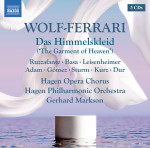|
Back
01/04/2023
Ermanno Wolf-Ferrari: Das Himmelskleid
Angelina Ruzzafante (the princess), Sibrand Basa (the prince), Reinhard Leisenheimer (the chancellor), Stefan Adam (Prince Korbinian), Sergio Gómez (Prince Gudolin, the beggar), Peer‑Martin Sturm (Prince Fridolin), Michael Kurz (Prince Pippin), Anna‑Maria Dur (the moon fairy), Opera Chorus and Augmented Chorus of Theater Hagen, Granville Walker (répétiteur), Hagen Philharmonic Orchestra, Gerhard Markson (conductor)
Recording: Stadthalle Hagen, Germany (January 22‑26, 1996) – 166’38
Naxos 8.660518‑20 (Distributed by Naxos of America) – Booklet in English and German

   
Ermanno Wolf‑Ferrari was best known for his comic operas. This included such works as the female-probing subject matter of Le donne curiose (1903), the Falstaff‑like absurdities inside I quatro rusteghi (1906), the riotous two‑way dialogue of Il segreto di Susanna (1909) and the witty dealings of La vedova scaltra (1931). But Wolf‑Ferrari also dabbled in the verismo with his colorfully melodramatic I gioielli della Madonna (1911), and in 1927, the German-Italian composer turned down another path by venturing into the kingdom of French poet and storyteller Charles Perrault. Das Himmelskleid is loosely based on his fairy tale Donkeyskin.
Premiering on April 27, 1927, Das Himmelskleid was not well received. Eight months later, Wolf‑Ferrari’s Sly opened in La Scala. These two works stand out amongst the others noted above due to their sophistication and maturity. Das Himmelskleid is a parable that deals with a princess’ (Angelina Ruzzafante) lack of appreciation for the lavish gift she already possesses (the garment), while simultaneously continuing to fuel her needs for more wealth and power. The sojourn, however, is suddenly stopped short by encountering the prince (Sibrand Basa) in a certain “reawakening”, and the ideas of redemption and forgiveness are suddenly ushered in. The music, highly symbolic, also has its moments of longueurs, and the score is a bit uneven.
Throughout the three act opera, Wolf‑Ferrari orchestrates with impeccable verve that indirectly (and occasionally) prods the stylization of Nielsen’s Maskarade. Use of brass is majestic and plush with royal fanfare, yet Wolf‑Ferrari could also concoct ethereal choral entrées and pontifications. Many of the vocal passages are woven together with meandering orchestral interludes, reminiscent in style to Wagner, but not necessarily in composition.
One notable issue found in Ermanno Wolf‑Ferrari’s style is his ability to fluidly paint an image with the greatest of ease. For example, in the travel to the world of air, numerous passages are strung along with orchestral segments...magical percussive and instrumental items give ethereal heft, such as the lofty celeste, triangle and cymbals. Act II opens with extremely long melisma lines that help conjure the image at the moment. Frequently, sudden halts in the music magnify the upcoming idée, all moving along with the greatest of ease.
The Prince’s visions are slight, polite and evenly supplanted by feathery buoyancies emanating from the strings. Sibrand Basa’s articulation is a tad thin, but the timbre is quite resolute. Wolf‑Ferrari had the ability to craft beautiful and dreamy clauses that pulsate below the normal line...infrequently getting over‑excited, but retaining lovely vocal elegancies.
Anna-Maria Dur’s richly vocal directness envelopes her mezzo voice around the role of The Moon Fairy, one that’s wholesomely celestial. Beams of dark radiances pervade the airways with open embraces, and her voice mounts a vibrant energy which charges forward with directness and with a mildly Straussian-enchantment. The conversation has a way of being suspended above the airways and simply keeps floating and floating away. There’s great enchantment in Wolf‑Ferrari’s passages at this point in time. The advantage of Angelina Ruzzafante in the role of the Princess is that her soprano voice is erudite, clarion and bordered by tremendously good projection.
It’s unfortunate to see the paucity of a write‑up in the booklet, and nowhere does it mention an external link to a libretto. This would clearly help since numerous singers are featured (in the principal cast) which are difficult to distinguish.
This Naxos release was originally recorded in 1996 under the Marco Polo label, and with its reissue, the sound and acoustics are rather rich, although pockets of volumetric inconsistency and moments lacking in bass richness prevail.
Christie Grimstad
|